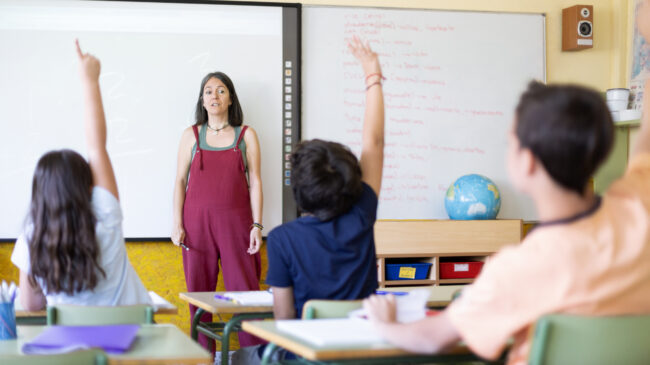Before the COVID-19 pandemic, most school districts had massively increased K-12 spending in recent decades. Reason Foundation’s Spending Spotlight found that inflation-adjusted K-12 education funding increased by more than $3,200 per pupil, or 25% nationwide, between 2002 and 2020. Education spending increased in 49 of 50 states between 2002 and 2020, even though student enrollments dropped in 22 states.
Three years ago this month, K-12 education spending skyrocketed even further when Congress appropriated the Coronavirus Aid, Relief, and Economic Security Act (CARES Act) in March 2020 in response to the pandemic. It was the first of three COVID relief packages that would ultimately total nearly $200 billion in aid for schools. This firehose of federal funding has already raised record-setting education spending levels even higher, with Burbio reporting that nearly 64% of school districts’ spending has increased by 15% or more since 2021.
The most recent reports on the 2024 fiscal year suggest that the trend of increased spending is continuing for school districts in Maryland, Virginia, Massachusetts, and Connecticut. Five out of the 15 state budgets reviewed by Burbio show spending rising by about 10% or more compared to FY 2023.
However, there’s a fiscal cliff on the horizon for many school districts, especially for districts that used temporary pandemic relief dollars to pay for recurring costs or spent the money hiring more full-time workers during a time of declining enrollment in many districts. When the federal relief funds dry up in about 18 months, these school districts could face “a perfect storm of financial pressures [that] will eclipse anything most districts have seen before,” warned Marguerite Roza, director of Georgetown University’s Edunomics Lab.
School districts that suffered severe enrollment drops during the pandemic or invested their federal relief funds poorly are most at risk. “It’s not unusual for a district to put off making tough (and unpopular) budget-cutting decisions. But any delay can make a bad situation worse, especially if the overspending continues in the interim,” Roza explained,
Unfortunately, school districts could pay a steep price for imprudent spending decisions since their budgets leave little margin for error. “If the budget gap represents more than about 2% of the total district budget, districts have no choice but to cut labor costs,” Roza wrote.
In fact, the average school district will likely have to cut costs by $1,200 per student during the 2024-25 school year, according to Roza’s estimations, making the projected funding gaps worse than those schools dealt with during the 2007-2009 economic recession.
School districts that face budget gaps of this scale could experience staff layoffs and even close schools. Minneapolis Public Schools’ “impending financial crisis” is an unwelcome harbinger for many school districts in similar straits.
With steep fiscal cliffs on the horizon for many districts, schools should prepare now, so staff and students aren’t caught off guard. For example, some Iowa school districts announced plans to combine class sizes and notified temporary hires that their two-year contracts are closing.
“We’re returning to the same staffing levels we were pre-pandemic. We knew that when we went in. One of the things we communicated to our building administrators was this will give you some relief in terms of class sizes when these dollars are available,” Iowa City schools chief financial officer Leslie Finger told The Gazette.
State policymakers, however, should be wary of calls to increase spending. Except for North Carolina, every state increased its per-pupil inflation-adjusted education spending during the almost two decades leading up to the pandemic when spending was already at record levels.
As school districts return to pre-pandemic spending levels, transparent communication with staff and affected families is critical to navigating budget shortfalls. At the same time, districts should rein in spending and avoid adding to recurring costs, opting instead for one-time bonuses, temporary hires, and cutting ineffective programs.
From the states
As lawmakers continue to examine education reforms, at least two states recently signed school choice proposals into law, and several other states continue to advance school choice proposals.
The Florida House passed House Bill (HB) 1, which would establish universal education savings accounts (ESAs) for students in the state. Families could use ESAs to pay for approved education expenses, such as private school tuition, books, or tutoring. However, the Heritage Foundation’s Jason Bedrick noted that the proposal, perhaps inadvertently, prohibits families from using their ESAs to pay for virtual education from religious providers.
In Missouri, the state House passed Rep. Brad Pollitt’s H.B. 253, which would establish voluntary cross-district open enrollment. Currently, the proposal would not allow more than 3% of students to transfer out of their assigned school districts.
West Virginia Gov. Jim Justice signed H.B. 2596 into law, establishing a robust open enrollment program. School districts must post their open enrollment policies and procedures on their websites and can only reject transfer applicants for limited reasons, such as lack of capacity. School districts cannot charge transfer students tuition.
Gov. Sarah Huckabee Sanders signed S.B. 294 into law, making education savings accounts available to all Arkansas students by 2026. The new law also lets all students participate in open enrollment, eliminating the 3% cap on transfer students.
What to watch
Texas policymakers have introduced sweeping education reforms. Texas State Sen. Brandon Creighton introduced Senate Bill 8 with the support of Lt. Gov. Dan Patrick. The bill would establish education savings accounts worth $8,000 each and was accompanied by Senate Bill 9, which would provide raises for teachers, provide free pre-k for teachers with children, and increase classroom spending.
Tim DeRoche launched Available to All, a nonpartisan watchdog group. This organization highlights the stories of students denied access to public schools that are a better fit because of where they live. “Available To All stands ready to defend the principle that public schools need to be ‘available to all on equal terms,’ as the Supreme Court requires,” notes the group’s website.
Edunomics Lab is launching a Spring Cohort of the Certificate in Education Finance, March 29-30 in New York City and April 12-13 in Los Angeles. The residency is followed by six weekly, two-hour live virtual sessions.
Recommended Reading
The surge in education savings accounts was decades in the making
Adam Peshek at Thomas B. Fordham Institute
“So my advice to ESA advocates is to not slow down. The wave of ESAs happening now was built on a decade of trial and error, with lots of error along the way. Had we heeded the warnings of those before, today’s wave would be a trickle.”
State education trends for 2023
Jillian Meinhardt and Catherine Van Ness at the National Governors Association
“This year, seven major areas in education policy have been highlighted, which include K-12 funding, workforce development and career and technical education, teacher staffing, early learning, academic supports, physical and mental health, and postsecondary affordability.”
Education Freedom and Student Achievement: Is more school choice associated with higher state-level performance on the NAEP?
Patrick J. Wolf, Jay P. Greene, James D. Paul, Matthew Ladner at Journal of School Choice
“School choice has its best chance to influence NAEP scores and gains across an entire state by delivering competitive pressure to district-run public schools. When that competitive pressure is especially intense, because it comes from multiple sources of public and private school choice, the constructive response from affected public schools is likely to be most clear and consistent across the state.”

